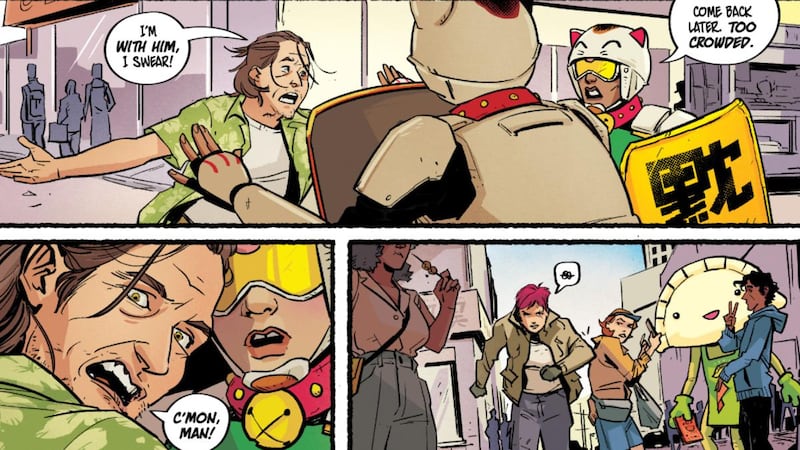Madi Preston has had better weeks on the job. As an elite operative for J-Squad, one of several privatised special forces outfits that dominate life in a near-future tech dystopia, she has a lot on her plate; several hacked brains, one stolen child and more very large guns than you can shake a USB stick at. It’s enough to put any worker off the high-tech security, surveillance and espionage they’ve been trained to do but, luckily for us, she’s not the quitting type. And in Madi, the new graphic novel from Duncan Jones, Alex de Campi and a mouth-watering cabal featuring some of comics’ best artists, we get to witness every BAM, BOOM and BRAKKABRAKKABRAKKA along the way.
The last decade has seen a steady migration of comics properties to screens large and small. Six of 2018’s Top 10 grossing films were spawned from comics properties. (A seventh, The Incredibles 2, merely aped the superhero genre without ever having had a textual forebear.) Perhaps, then, it’s surprising when traffic moves the other way, as when director Duncan Jones abandoned the idea of filming Madi – a long-gestating third film in his Mooniverse trilogy – and opted for the page instead.
“It was an actual film script,” Jones says of Madi, gesticulating from his home in LA over Zoom. His gestures imply an imaginary, but noticeably thick, script held between clenched hands. Jones is, of course, the film director behind Moon, Source Code, Warcraft and Mute. He is animated in conversation, fizzing with enthusiasm as he and co-writer Alex de Campi cut across each other over a wide-ranging hour, spiralling into conversational by-lanes that cover books, movies, and a surprisingly long detour through the best places in London to get barbecue food.
“That script was quite a beast”, he recalls, “so I asked Alex if she’d be interested in helping me turn it into a graphic novel”.
Multiple artists
De Campi had been recommended by a few of Jones’ friends, having penned indie comics like Smoke, Bad Girls and the Twisted Romance anthology series. She’s also helmed a long list of action-packed properties for DC, 2000AD and Marvel, not to mention the sheer, propulsive, lip-biting delight of last year’s horror romp Dracula, Motherf**ker. But, writing aside, she’s quick to emphasise the other skills she brought to bear.

“I’m really good at project management,” she says, with a relish for that artform rarely seen outside of corporate away days. “It was a pretty big task. But I read Duncan’s script and saw that it was a road trip film, so there were discrete locations and specific characters that multiple artists could own.”
The upshot was a sprawling action thriller, pitched somewhere between Ghost & The Shell and Total Recall, told via 17 different top-tier comics artists. Each of these took responsibility for a discrete section, and this gives them ownership of elements of the story, to avoid the Exquisite Corpse feeling such an approach could have engendered. Madi is thus a large project in every sense of the word.
At over 300 pages long, it tells a story that spans several countries, told by two writers, 17 artists and a dozen colourists. Its deluxe hardcover form suggests a runaway child. This is not, to put it mildly, a book you can imagine being blown away by a strong wind. With so much going on, and a visual style that switches every few pages, was there a risk that too many cooks might spoil the broth?
“It wasn’t like we keep seeing the same location in different hands” she stresses, “which could have been a bit weird. Like having Gotham City painted by five different people in the same book and you’re like ‘is this the same city?’
“I thought out the visual philosophy, in detail. Almost every time a new artist takes over, it’s a double-page spread and they get to splash their art all over it. You turn the page physically and you’re in their world. We do mix it up later on, but then the only reason you set up rules in a work of fiction is to break them in the most interesting ways possible.”
Childhood relic
So why a graphic novel? There is a pause in LA, as Jones scrunches his face and holds his hands, in the manner of someone begging to be heard out. “I might talk a lot of b*llocks so forgive me”, he says, “but there was an old comic I used to love called The Trigan Empire that was this big beast of a book. It was so compelling and so massive. Both physically, and visually. It’s properly my book, look” – at this point, he holds the giant volume to camera, its frayed edges confirming it as a well-thumbed relic of his own childhood – “and it just swallowed me up. The idea of a graphic novel like that has always sat with me ever since.”

“We were also trying to make something that wasn’t a movie,” adds de Campi. “Really specifically, comic book-only things and storytelling techniques. Maybe Madi will be a movie one day, but comic books aren’t storyboards. They are so much richer. There is so much you can do on a page, so many little nerdy, storytelling techniques you can’t replicate on film; using them was a big goal. Not only to localise the story, but localise it into a medium where it could be really innovative in its own right – as a comic.”
“I go back and forth between whether it should have been a film”, says Jones, “because that’s what I do, so before we did the graphic novel, I thought ‘oh we’d never be able to do that’ about this or that thing, but the unique experience of working with Alex and this team of artists is they just did things I wouldn’t have thought of. I don’t have too much of an ego to say that. It’s been elevated in ways I would never thought of doing it.”
Some of these elevations included adorning one group of corporate paramilitaries in Shanghai with hyper-cute robo-kitten outfits.
“The kitty cops!” Jones yelps, “that would never have occurred to me, and when Alex suggested those, I was like “YES! Do it!”
“The justification,” says de Campi “was, if we make fascism cute – people will accept it more. It’s okay if people have guns but they look like cute cats.”
Techno-capitalist monsters
I venture that, while most of the best-selling speculative fiction created in the 20th century focused on extra-terrestrial threats, it seems like today’s sci-fi takes aim at more human antagonists. If the most feared archetypes of futuristic thrillers were little green men with death rays, are our worst fears now of techno-capitalists?
“The fears are getting worse because they’re getting more right!” he laughs. “You see Facebook and Twitter going off to senate hearings on what they’re doing with their technology and you’re like ‘yeah, this is not good!’

“Texas just experienced cold weather,” adds de Campi, “and because they’ve privatised all the power and water systems, everything stopped working. There was no power, there was no water. People in Texas don’t have heaters because you don’t need heat in Texas, you need the opposite. And people were dying, and then being charged insane amounts when it came back on. Look at the American healthcare system, there is a corporatisation of things that has already sunk its teeth into so much. Duncan just made it a little more absurd, that’s all. It’s not unrealistic.”
They are, at least, more sanguine about one aspect of our current tech landscape, the crowdfunding platform which allowed their project to come to life via a Kickstarter campaign that raised $366,000.
“Economically, comics are really weird,” says de Campi. “It’s a lovely medium but increasingly it’s becoming a road map to film and people aren’t focusing on being profitable making comics, they’re thinking ‘oh maybe we’ll option this for film and if it loses money and we only print 2,000 issues’. This also includes a lot of abuse of creators.”
“That was another thing,” interjects Jones. “We made it clear, right up front, that we wanted to pay people their rate.”
“A couple of the younger ones,” continues de Campi, “we had to tell them ‘you’re not asking for enough, this has to be more, it has to be a fair rate’.”
All that being said, will this success take him away from the camera for another trip back to the drawing board?
“I have the tiniest seed of an idea,” says Jones, coyly. “I haven’t even run it past Alex. I’d love to talk to her about it. If she likes it, I’ll keep nurturing it.”









